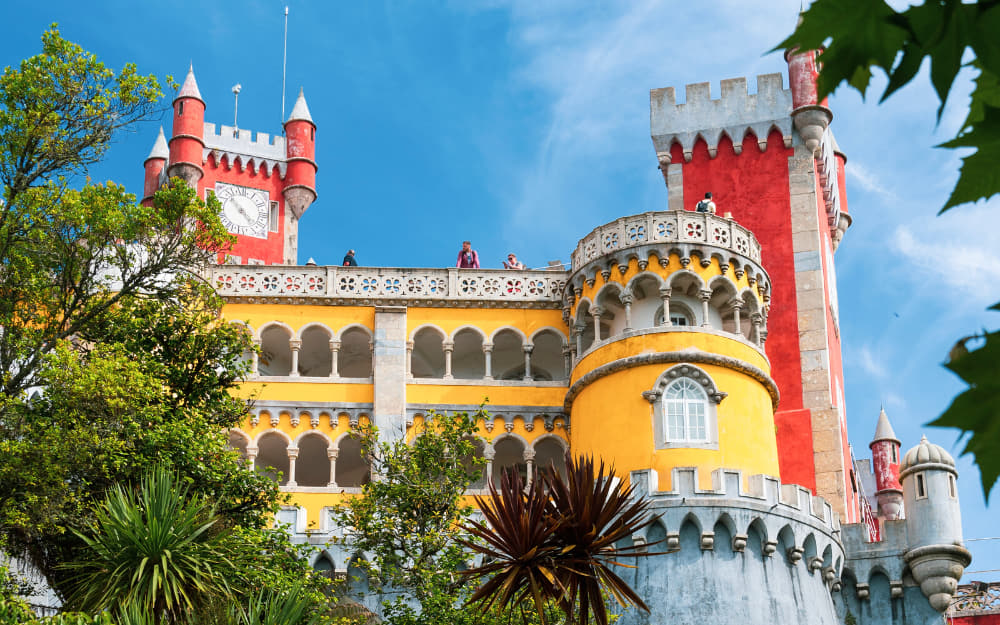Discover 27 of the best and most famous landmarks in Portugal that encapsulate the country’s rich history, vibrant culture, and natural beauty. From iconic castles to stunning coastlines, explore the must-visit spots that define Portugal.
With a history dating back thousands of years and with the official establishment of the Kingdom of Portugal in the 12th century, present-day Portugal (now a Republic) has a rich and colourful past.
Today, this is evident in not only the medieval villages, towns, and architecture but also in the incredible array of famous landmarks in Portugal, both natural and man-made.
That’s why I’ve decided to collate a list of quintessential and iconic landmarks in Portugal that you should check out on your next Portugal vacation!
Ranging from the sun-kissed beaches of the Algarve to the historic streets of Porto, and the awe-inspiring Jerónimos Monastery in Lisbon, these Portuguese landmarks offer a glimpse into the heart and soul of the country.
Come with us on a journey as we explore architectural gems, witness breath-taking vistas, and delve deep into a culture enriched by a blend of Moorish, Roman, and native influences.
| Before you go, be sure to plan & book your trip! | |||
 | Browse & Book Hotels |  | Browse & Book Car Rentals |
 | Browse & Book Flights |  | Browse & Book Buses and Trains |
Pssst…Don’t forget to read our Portugal packing list post to ensure you’ve got all your travel essentials packed and ready for your holiday to Portugal!

Famous Landmarks in Lisbon & Surrounds
1. Pena Palace – Landmarks of Portugal

Pena Palace is one of the most colourful Portugal landmarks. This 19th-century Romanticist castle is painted a vibrant yellow and red. It’s perched on a hill in the lush Sintra Mountains and contrasts beautifully with the forested landscape.
The site where the castle rests previously held the ruins of an old monastery. King Ferdinand transformed the remains into a fairy-tale-like palace between 1842 and 1854 to serve as a summer residence for the Portuguese royal family. Ferdinand and his wife, Queen Maria II, had a direct say in the castle decoration and symbolism.
This is one of the most quirky historical places in Portugal. Touring Pena Palace, and in fact visiting the village of Sintra from Lisbon is an experience you don’t want to miss.
2. Belém Tower – Famous Landmarks of Portugal

The Belém Tower is one of the most striking Lisbon, Portugal landmarks. It was built using lioz limestone between 1514 and 1519. It served as a fortress to defend the city from attack. It was also the first and last thing sailors would see from their country when taking voyages. For this reason, it became a symbol of their homeland.
The tower enjoys a picturesque location on the banks of the Tagus River and is isolated from the mainland by a single bridge. Visitors can climb the spiral staircase to the top of the tower and take in the beautiful views of the city and the river. This landmark is a must-see on any Lisbon itinerary.
3. Castle of São Jorge

The São Jorge Castle historic landmark in Portugal is an 11th-century medieval fortress built during the Moorish period.
The castle’s original purpose was to house military troops, and in the event of an attack, to shelter the elite. It wasn’t until the 12th-century that the castle began being used as an official royal residence.
Today, it’s one of the most important historical sites in Portugal. Visitors can tour the castle and admire the ancient architecture and modern exhibitions. Several of the castle towers are also accessible; each feature astonishing views of the city and sea. The ground’s elaborate gardens and an underground archaeology museum are also open to the public.
4. Praça do Comércio

Praça do Comércio (Square of Commerce) is another one of Lisbon’s landmarks noted for its stunning architecture. The impressive plaza is enclosed on three sides by distinguishing yellow Pombaline style buildings. A large statue dedicated to King Joseph I stands in the centre.
The Arco da Rua Augusta (Rua Augusta Arch) occupies the entrance of the square. There is a viewing platform at the top of the arch that towers 30 metres high. It offers panoramic views of the Baixa district of Lisbon. The entrance fee is €2.50.
This is one of the biggest squares in Europe, and one of the highlights of Lisbon. The spacious square is a hive for tourist activity. It allows plenty of space for strolling and contains lots of inviting cafes to relax and enjoy a coffee.
5. Quinta da Regaleira

Located in the beautiful town of Sintra, Quinta da Regaleira is one of Portugal’s historical sites that truly astonishes. This 20th-century palace and chapel are unique and full of artistic beauty. The facade is characterised by an octagonal tower, Gothic pinnacles, and gargoyles.
The lavish park is just as exquisite as the castle – if not more. It contains lakes, grottoes, fountains, wells, and unusual statues referencing mysterious symbols. There is also an extensive system of underground tunnels and several initiation wells.
Quinta da Regaleira is one of the highlights of Sintra and among the most famous landmarks in Portugal.
6. Monument to the Discoveries

Standing tall at 52 meters (170 feet), the Padrão dos Descobrimentos, known as the Monument to the Discoveries, emerges as an imposing tribute in Lisbon. Its soaring stature recognizes the profound Age of Discoveries that characterized Portugal’s history.
On the pavement right in front of the monument is a compass rose incorporating a Mappa Mundi gifted to Portugal by the South African government. It is a giant limestone map of the world where you’ll learn about the important dates in history on the monument.
Set against the picturesque backdrop of the Belém riverfront, the Padrão dos Descobrimentos monument draws a crowd as a reminder to Portugal’s commitment to discovering new lands. The landmark stands close to other iconic landmarks like the Belém Tower and the Jerónimos Monastery.
The monument is an assembly of 33 prominent navigators that defined Portugal’s nautical explorations. Leading this symbolic ship is none other than Prince Henry himself. And just behind him, an illustrious procession of other known Portuguese explorers such as Vasco da Gama, Ferdinand Magellan, and Bartolomeu Dias.
7. Ponte 25 de Abril

Originally christened after Prime Minister (and dictator) Salazar during its inauguration in 1966, the bridge underwent a name change following the 1974 revolution on April 25th. Though bearing a resemblance to San Francisco’s Golden Gate Bridge, it was actually modeled after the Bay Bridge of the same city, and intriguingly, assembled by an American firm.
Distinguishing itself with a central span surpassing even the Golden Gate’s expanse, the bridge forms a vital connection between Lisbon and the sun-kissed shores of Costa da Caparica, where you will find some of the best beaches in Lisbon, extending its reach to the southern regions of Portugal.
Among its fourteen robust pillars, one dubbed “Pilar 7” stands as a house of knowledge, as it contains an exhibition that chronicles the intricate narrative of the bridge’s creation. Within these walls, the very mechanics underpinning the suspension bridges stand revealed.
Lastly, you should not miss ascending an elevator that culminates in a glass-encased observation platform atop. From this vantage point, the river and the city unfold with stunning views of Lisbon.
8. Santa Justa Lift, Lisbon

Nestled in the heart of Lisbon’s downtown bustling Baixa-Chiado district, lies the Santa Justa Lift, one of the city’s most well-known and recognizable landmarks.
Built in 1902 by the apprentice of Gustave Eiffel, Raoul Mesnier de Ponsard, this Neo-Gothic marvel serves both as public transportation and a viewing platform. For a small fee, you can escape the steep climb of Lisbon’s hilly streets and ascend 45 meters to reach the ruins of the Carmo Convent and the connecting walkway to upper Chiado, as well as Bairro Alto, another historic neighborhood in Lisbon.
The lift itself is an impressive engineering feat, boasting intricate ironwork and boasting panoramic views from the top that definitely steal the show, offering sweeping vistas of the Rossio Square, the Castle of São Jorge, and the Tagus River. For the best experience, visit during sunset when Lisbon’s terracotta rooftops glow in the fading light.
It is worth noting that this is quite a popular landmark in Lisbon and it’s not uncommon to find long queues of eager tourists wanting to ride the lift up. If you’re not in the mood to wait in line you could always head up the hill to the gorgeous Largo do Carmo square, and then head over to the lift where you can access the upper viewing points free of charge too!
Portuguese Landmarks in Porto
9. Famous Portugal Landmarks – Dom Luis Bridge

The Dom Luis Bridge is a double-deck metal bridge located in the northern city of Porto. It crosses over the River Douro and connects the Port wine cellars of the Vila Nova de Gaia neighbourhood with the lively Ribeira neighbourhood.
The bridge was built in the late 19th century. It features two levels, with a large arch in the middle. Both levels have pedestrian walk-ways, but the top-level offers stunning views 60 meters above the river and the city. This is also the level that the tram rides over when crossing between the city sections.
10. Clerigos Church and Tower – Porto

When visiting the north of Portugal, you cannot miss this famous Landmark in Porto. One of the city’s most iconic and imposing landmarks, the Clérigos Church and Tower, is a masterpiece of Baroque architecture designed by the Italian architect Nicolau Nasoni.
Completed in 1763, the church is a true sight to behold and a fascinating visual delight with its ornate carvings and gilded altarpieces, but the real star is the adjoining tower. Standing at 75.6 meters, the Torre dos Clérigos is the tallest campanile in Portugal and offers breathtaking panoramic views of the city.
When we visited the tower we took to climbing the tower’s narrow, spiraling staircase of 225 steps and once we reached the top, were rewarded with sweeping vistas of the Douro River, Ribeira District, and beyond.
A word of caution, the steps are super narrow and the tower very high, so if you are either claustrophobic or have a fear of heights, I would not recommend you climb to the top.
Another tip is to visit the Clerigos Church at 12:00 any day of the week to enjoy a free organ concert. Definitely not to be missed!
11. Bolsa Palace (Palácio da Bolsa) – Porto

Perhaps one of the most elegant Porto landmarks we visited is also one that is steeped in history. The Palácio da Bolsa in Porto is situated in the heart of Porto’s historic center, this 19th-century Neo-Classical building was originally a stock exchange and serves today as the headquarters of Porto’s Commercial Association.
From the outside, the palace impresses with its grand and imposing façade, but the interior is where the true magic lies. To visit here, you have to book a guided tour and it’s best to secure your tickets in advance as it is quite a popular spot to visit.
The centerpiece and last stop of your tour of the complex will be the Arabian Hall, a stunningly decorated room inspired by the Alhambra in Spain, and covered in ornate gilded carvings and intricate Moorish designs. Definitely a show stopper of a room and one that had us marveling and snapping away for quite some time!
Whether you’re a keen history buff, have an affinity for stunning architecture, or simply someone keen on capturing the essence of the city, the Palácio da Bolsa is a must-visit Porto landmark that offers a glimpse into the city’s opulent past.
Famous Natural Landmarks in Portugal
12. Benagil Sea Cave

The Algarve region is known for gorgeous beaches, dramatic coastlines, cliffs and caves.
The Benagil Sea Cave is a beautiful Portugal landmark that isn’t man-made. This natural rock formation is located near the town of Algarve. It’s one of the most unique sea caves found anywhere in the world.
It has a distinctive hole on the top that allows the sun to shine in and onto the sandy beach area inside the cave. You can reach the top of the cave on foot. However, a Benagil Sea Cave boat tour is the only way to reach inside the caves.
13. Berlengas Island

For those who enjoy a more off the beaten path experience, the Berlengas Islands offer an idyllic escape. Situated roughly 10 kilometers off the coast of Peniche, these rugged, uninhabited islands are a haven for nature lovers and adventure seekers.
A UNESCO Biosphere Reserve, Berlengas is home to rare plant species and nesting seabirds, providing excellent opportunities for birdwatching and those interested in the botanicals found naturally in Portugal.
The jewel of the archipelago and the most visited is Berlenga Grande, the largest island, that offers dramatic cliffs and crystal-clear waters that are perfect for snorkeling and diving.
One must-see attraction is the Forte de São João Baptista, a 17th-century fort accessible by crossing a narrow pathway that spans across the sea. Here, history and nature coalesce, offering panoramic views that will leave you spellbound.
To visit, you can hop on a ferry from Peniche for a day trip, and enjoy the uniqueness and natural beauty that this small archipelago has to offer up!
14. Pico Mountain

For those outdoor enthusiasts who love to mix adventure with natural beauty, Pico Mountain on the Azores island of Pico offers an unforgettable experience. As the highest peak in Portugal, this now dormant volcanic mountain soars to an elevation of 2,351 meters (7,713 feet), providing a challenging yet rewarding ascent.
The climb is a hiker’s dream, and offers ever-changing landscapes from lush forests to stark, other wordly craters as you approach the summit. As one of the most rewarding hikes in Portugal, and one of best hikes in the Azores, this is definitely meant for experienced hikers!
The peak itself will offer climbers sweeping views of the surrounding islands and the vast Atlantic Ocean—a breathtaking reward for your hard effort to get to the top.
If you’re keen to take on this challenging climb you may opt for a guided tour, which not only provides valuable insights into the mountain’s geological and cultural significance but also ensures a safer ascent.
Religious Landmarks in Portugal
15. Jerónimos Monastery

The Jerónimos Monastery is another one of Portugal’s famous landmarks. Construction for the monastery began in 1501 and wasn’t completed for another 100 years. It’s a beautiful example of the Portuguese late Gothic architecture style.
The Hieronymite monks originally lived and worshipped in the monastery. Later, it became the final resting place for members of the Portuguese royal family.
This large building is appreciated for its ornate carvings and decorations. Especially eye-catching are the richly detailed columns carved with maritime symbols and the unique double story cloister design.
16. Alcobaca Monastery – Religious Landmarks Portugal

The Alcobaca Monastery is a 12th century Roman Catholic building founded by the first Portuguese king, Afonso Henriques. Located in Alcobaça, Portugal, it was the first-ever Gothic building in the country.
The facade has impressive stone detailing and features a mix of styles. The portal and the circular rose window were part of the original church. At the beginning of the 18th century, statues and the two towers were added.
As required in Cistercian churches, the interior walls and columns of the church lack any sort of decoration. There are rows of windows that give the building plenty of light. This over 800-year-old monastery is very well maintained and a true gem of Portugees architecture.
Tip: Combine a visit to Alcobaça together with Batalha and Tomar which together form what is known as the ‘Monastic Triangle of Portugal’, a great day trip from Lisbon.
17. Batalha Monastery

Whether you love architecture, are a history buff, or simply wanting to explore the rich heritage and history that Portugal has to offer, the Batalha Monastery offers you a glimpse into the country’s past, showcasing some incredible craftsmanship that has largely remained in tact till today!
The Batalha Monastery, which is also a UNESCO World Heritage site, is located in the small town of Batalha, situated just under 2 hours by car from Lisbon. It is a true marvel of Gothic and Manueline architecture and was built to commemorate Portugal’s victory in the Battle of Aljubarrota in 1385.
As you meander through the elaborately carved entrance, you’ll instantly be swept up by the intricate details of the façade. The interior of the monastery is just as breathtaking, featuring an incredible blend of stone filigree work, ribbed vaulting, and towering columns.
One of the key highlights found here is the Founder’s Chapel, the final resting place for King João I, his wife Queen Philippa of Lancaster, and their famous children, including Henry the Navigator.
Whilst visiting, don’t miss out on visiting the Unfinished Chapels, a series of seven chapels with open sky above, revealing the monastery’s incomplete history.
18. Capela dos Ossos – Chapel of Bones – Évora

Perhaps one of the most haunting, yet mesmerizing attractions in the Capela dos Ossos, or Chapel of Bones, located in the historic walled city of Évora.
This tiny, 16th-century chapel is certainly not what you may expect from a typical religious site. Instead of paintings or statues, the walls and columns are adorned with the bones and skulls of over 5,000 individuals. Inscribed above the entrance are the chilling yet somehow poetic words: “Nós ossos que aqui estamos, pelos vossos esperamos” – which translates as: “We bones that are here, await yours.”
This fascinating chapel was created by Franciscan monks to serve as a meditative space meant to be a reminder of the transience of life and the inevitability of death. It’s a room where silence speaks volumes, inviting visitors to ponder their own mortality and the fleeting nature of earthly pleasures.
Whilst some visitors may find the chapel somewhat unsettling or macabre, I must say, our visit here was truly a special one. There is a definite sense of peace and calm as you enter the space and it’s a fascinating landmark in Portugal that I absolutely recommend you visit.
19. Sanctuary of Our Lady of Fátima

As one of the most important Catholic sites in the world, The Sanctuary of Our Lady of Fátima is not just a well-known landmark in Portugal; it is in fact a pilgrimage site that holds immense spiritual significance for millions around the world.
Located in the small town of Fátima, roughly 90 minutes from Lisbon by car or bus, the sanctuary marks the site where three shepherd children claimed to have seen apparitions of the Virgin Mary in 1917. Today, the sprawling complex includes the iconic Chapel of the Apparitions, a simple, yet moving structure built on the very spot where the visions occurred.
The modernist Basilica of the Holy Trinity contrasts the more traditional Our Lady of the Rosary Basilica, providing a blend of old and new that resonates with visitors of all ages.
Whether you visit this site for religious devotion or cultural learning, the atmosphere of peace and reverence is palpable. Visit during one of the annual pilgrimages (May and October) for a truly transformative experience.
Other Historic Landmarks in Portugal
20. Óbidos Castle

Óbidos Castle is a well-preserved medieval castle that dates back to the 8th century and a prime example of medieval landmarks in Portugal. It resides in the small historic town of Óbidos, in eastern Portugal. The castle walls surround most of Óbidos’s quaint old city.
Today, the castle operates as a heritage hotel, and the only way to see the inside is to book a room and spend the night. The interior is refurbished but retains a style reminiscent of ancient times.
Visitors can freely access the battlements and the perimeter of the castle walls. The west wall offers stunning views of the town and the countryside’s beautiful vineyards.
21. Templo De Diana Evora

The Roman Temple, an ancient marvel, stands as Évora’s prime monument. It boasts unrivaled historical significance in the nation’s history.
Dating back to the first century under the reign of Emperor Augustus, the Roman Temple in Évora carries a storied legacy. Its existence was interrupted by its destruction during the fifth century when Barbarian forces took hold of the Iberian peninsula. Subsequently, it found itself repurposed within the premises of Evora Castle during the 14th century.
The temple’s original Roman blueprint, lost to the annals of time, was resurrected during the 19th century—a pioneering archaeological venture in Portugal. This timeless structure stands as a living testament to Évora’s Roman forum.
This revelation dismissed the misunderstanding that it was dedicated to the goddess Diana, a tradition that persisted for centuries, thereby earning the moniker “Temple of Diana.”
22. Castle of Marvão

The Marvo Castle, perched on a rocky peninsula, commands the western extremity of Marvão village. A massive arched reservoir lies at the entryway, revealing the castle’s utilitarian infrastructure.
The highest point of the Keep offers spectacular views of the castle’s many enclosures, particularly the battlemented towers and watchtowers placed on the cliff’s edge.
It is possible to wander around the city by walking through the castle’s walls. From its battlements, you can see the city of Marvão, the Serra de São Mamede (Mountain Range), the Serra da Estrela, Castelo Branco, and the Spanish mountain ranges.
From this elevated vantage, the Marvão Castle provides an immersive experience that melds history, architecture, and breathtaking panoramas into an unforgettable whole.
23. Monsaraz

Regarded as one of the earliest Portuguese settlements in the southern reaches of the country, Monsaraz carries a historic legacy. With Neolithic remnants tracing back to prehistoric epochs, this hilltop village’s pedigree goes all the way back.
Evidently the endurance of its history, Monsaraz has witnessed its share of conflicts. Blessed with a strategic placement atop the landscape and its commanding elevation, this site has hosted a multitude of inhabitants across ages, encompassing the Romans, Muslims, Mozarabs, and the Knights Templar, among others.
24. Cape St. Vincent Lighthouse

The Cape St. Vincent Lighthouse, or Farol do Cabo de São Vicente, situated near Sagres at the Cape of St. Vincent, marks the farthest southwestern point of continental Europe. This locale merges elements of nature, culture, and legend. Access to this iconic landmark is exclusively by car, with free parking available adjacent to the lighthouse.
Today, the St. Vincent Lighthouse is the most popular landmark at Cape of St. Vincent. This structure, which traces its origins to a 16th-century Franciscan convent, emerges as a symbol of maritime navigation prowess.
Erected in 1846, it has undergone successive expansions and modernizations, evolving to accommodate the Museu dos Faróis, or the Lighthouses’ Museum. The latter stands as a tribute to Sagres’ pivotal role in Portugal’s maritime explorations and seafaring history.
25. Silves Castle

The Silves Castle stands as Portugal’s most impeccably maintained Moorish fortress.
Built from red sandstone, Silves’ castle reigns as an emblem of Moorish legacy, a testament to their dominion over the Al-Gharb (Algarve) from the 8th to the 13th centuries. In those days, Silves, known as Xelb, blossomed into a vital hub of commerce and intellect, reigning as the capital of the Al-Gharb.
A visit to Silves is incomplete without ascending the labyrinthine streets leading to the castle, a path that culminates in panoramic vistas from the castle’s ramparts.
Though remarkably well-preserved, credit is due to extensive restoration efforts undertaken in the 20th century, bestowing upon it the distinction of possibly being the Algarve’s most pristine medieval castle.
26. Mafra National Palace – Famous Landmarks in Portugal

Just a short drive from Lisbon by car, or by bus, lies the Mafra National Palace, a colossal Baroque and Neoclassical palace complex that’s impossible to ignore.
Conceived by King John V in 1717, it was constructed using the wealth from Brazilian gold and is known to have almost bankrupted the country. It boasts 1,200 rooms spread across an awe-inspiring façade of over 220 meters.
It was originally designed as a royal residence and also includes a magnificent basilica and a well-known library containing over 36,000 ancient books and that is known for its fascinating use of bats to keep bugs away.
This palace is huge and it took us the better half of a morning to complete a tour of the space. When visiting you will no doubt be captivated by the ornate interiors, featuring Italian marble and Brazilian gold leaf. The basilica, adorned with statues and intricate altarpieces, houses six historical pipe organs and two carillons, comprising 92 bells.
27. Forte de Nossa Senhora da Graça

Another truly off-the-beaten-path landmark that hardly anyone knows of but still adds its fair share of history is the impressive Forte de Nossa Senhora da Graça situated in Elvas.
This unique fort sits atop a hill, providing amazing views of the surrounding area and the fortified town of Elvas, a UNESCO World Heritage site.
Built in the 18th century with the main purpose to protect the region from Spanish invasion, the fort itself is an engineering feat that features a unique star-shaped design.
When you visit and as you wander through the labyrinthine of tunnels and climb the steep ramparts, you can almost sense the whispers of soldiers who once manned this fortress. Inside the complex, the former barracks and chapels have all been transformed into informative exhibitions about the fort’s history and military architecture.
We would highly recommend a visit to the Forte de Nossa Senhora da Graça as it is not just a step back in time, but also a journey and discovery of Portugal’s rich military past.
Disclaimer: This post contains links to services or products that I trust and recommend and from which I may earn commissions. Read our privacy policy for more.



